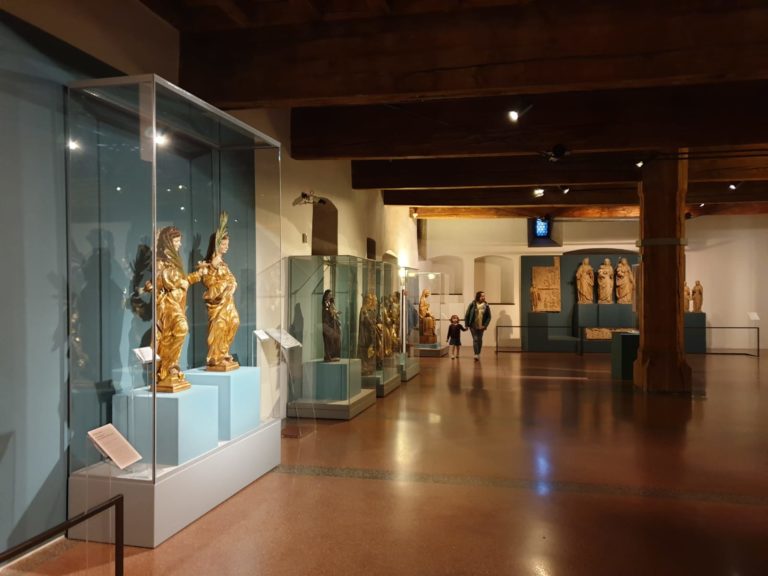It’s reductive and not very enriching to put in a blog post what history and memory manage to evoke through the magnificence of such an incredible castle. The purpose of these few lines is, therefore, to make some small suggestions to readers in order to invite them to visit Trento province and one of its most precious pearls, a few kilometers from the Rovereto Hostel.
Are you curious and ready to welcome some interesting ideas?

A little (a lot) of history …
The history of this Renaissance residence, equal in beauty to the most noble of rich central Italy, has its roots when the Alpine strongholds had exclusively military functions. The castle is an architectural construct built over the centuries, by adding new buildings or reinterpreting existing works of the most important bishop princes, making the castle more fashionable and functional every time.
The original keep of Buonconsiglio, the symbol of the castle, was built at the beginning of the thirteenth century, with defensive functions. Together with the adjacent Castelvecchio, it was the residence of the first bishops. Of the initial part this chronology, it’s important not to miss the splendid Venetian loggia. From there, the view of the city is one of the symbols and memories that will remain most impressed upon you, as well as the frescoes of the internal courtyard of Castelvecchio loggia; the challenge is yours to discover where the great emperor Charlemagne was depicted.
Also not to be missed is the splendid hall of the bishops on the top floor of Castelvecchio. It has an enchanting frescoed frieze that summarizes the history of the principality from 1027 to 1803, through the figures of the successive bishops over the centuries.

A little (a lot) of history …
The history of this Renaissance residence, equal in beauty to the most noble of rich central Italy, has its roots when the Alpine strongholds had exclusively military functions. The castle is an architectural construct built over the centuries, by adding new buildings or reinterpreting existing works of the most important bishop princes, making the castle more fashionable and functional every time.
The original keep of Buonconsiglio, the symbol of the castle, was built at the beginning of the thirteenth century, with defensive functions. Together with the adjacent Castelvecchio, it was the residence of the first bishops. Of the initial part this chronology, it’s important not to miss the splendid Venetian loggia. From there, the view of the city is one of the symbols and memories that will remain most impressed upon you, as well as the frescoes of the internal courtyard of Castelvecchio loggia; the challenge is yours to discover where the great emperor Charlemagne was depicted.
Also not to be missed is the splendid hall of the bishops on the top floor of Castelvecchio. It has an enchanting frescoed frieze that summarizes the history of the principality from 1027 to 1803, through the figures of the successive bishops over the centuries.

Only a century later in the fourteenth century, the magnificent Torre Aquila and its cycle of frescoes are an admirable example of international Gothic. Thanks to the skillful hand of Wenceslaus, the cycle of months represents the life of courtiers and peasants of the late Middle Ages. The wealth of details, the preciousness of the finishes, and the social cross-section emerge from these frescoes and really leave you breathless. A small interpretative detail reveals the lack of the pictorial technique of perspective. The different sizes of the figures are represented as social differences.
The heart of the Buonconsiglio Castle is the central Magno Palazzo, an example of incredible beauty and refinement from the most prosperous period of the principality. The Prince Bishop Bernardo Cles, through the contributions of some of the most famous painters, sculptors and architects of the Italian Renaissance, had the majestic residence built. To remember some artists who worked at the court of Bernardo Cles, we mention Dosso Dossi and Fogolino. Absolutely unmissable for its beauty is the loggia by Romanino. Portraits of kings and emperors clearly show the political function of the room where the prince granted audience.

With the advent of the nineteenth century and the end of the principality, the glorious splendor of the castle gave way to an Austrian ruler who transformed the beauty into an army barracks, with consequent and imaginable predations. There was looting and disfigurement, especially of the most beautiful rooms. Almost nothing remains of the original furniture. In some rooms, thanks to the work of professionals and enthusiasts, some things have been recovered. However, the regret remains, of not being able to relive the original emotions of those who lived in these spaces for centuries.
Finally, we mention the chronicle of the last century. During the First World War, Lieutenant Cesare Battisti was executed in the so-called martyrs’ pit, behind the castle. A few weeks earlier, he had been captured together with second lieutenant Fabio Filzi in the battle on Mount Corno, near Rovereto. The ancient forest of the castle’s deer, together with cells where the Italian patriots, Fabio Filzi and Damiano Chiesa, were locked up, became symbolic places of Tridentine irredentism.
Tips and Tricks
The minimum visiting time is a couple of hours. Don’t forget to ask the Info point for the map of the Buonconsiglio Castle. It’s very large and almost like a labyrinth in some parts .
At the end of the route we recommend a final rest break at the refreshment point. From there, a alk in the courtiers’ gardens will further enrich the already pleasant memory of the majesty of Buonconsiglio Castle in Trento.
Do you particularly like the charm of the castles of the Alps? We advise you not to miss another three magnificent examples of early medieval castles: Beseno Castle, Rovereto Castle, and Stenico Castle.
